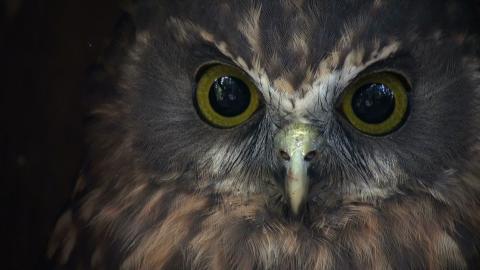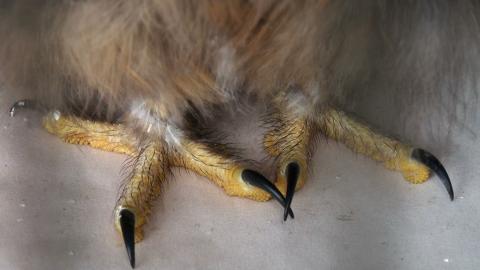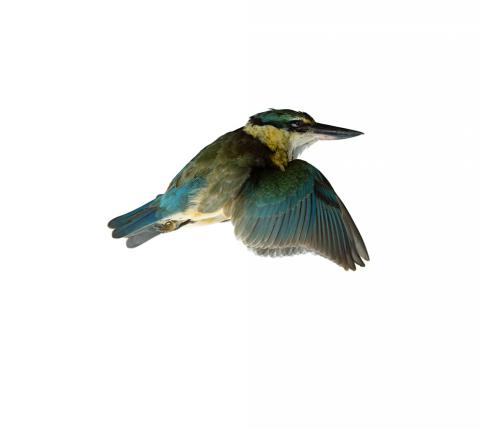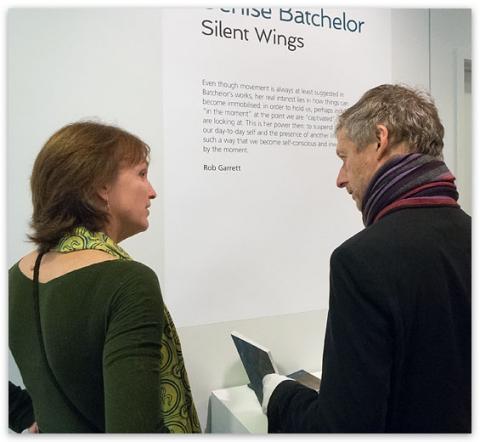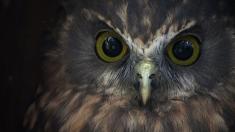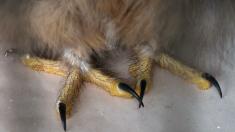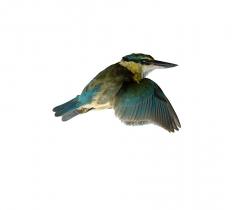Denise Batchelor
Stasis without death
Even though movement is always at least suggested in Batchelor’s works, her real interest lies in how things can become immobilised; in order to hold us, perhaps indefinitely, in the moment at the point we are captivated by what we are looking at. This is her power then: to suspend us between our day-to-day self and the presence of another life form in such a way that we become self-conscious and inwardly stilled by the moment.
Denise Batchelor’s video “Ruru” 2011 has us face to face with a close-up image of an owl, seemingly looking right back at us. It is a rare and beautiful image, giving us close access to a secretive and often unseen presence in our domestic backyards, parks and wilderness areas. But it is also unsettling for the owl stares out at us, almost unblinking, with a penetrating and entirely interested gaze. Watching the owl, we may have the feeling we are being watched with far more intensity than we usually look at things. It is not only the owl’s wide-eyes with their massively dilated pupils that is transfixing; it is the way the owl swivels its head through a full ninety degrees while maintaining its full frontal gaze in our direction that is unnerving. We are being studied. Remembering certain science films I have seen, I know this rotating gaze is a technique by which an owl judges the precise distance between itself and, yes, its prey. Our possibly disinterested gaze at a video artwork is suddenly confronted with a gaze that we will recognise, at least unconsciously, as very interested.
This is Batchelor’s power: to place us in a space between our day-to-day self and the aspect of another life form, in such a way that we become self-conscious and inwardly stilled by the moment. Sometimes the first tell-tale signs are the way our body responds before we realise what’s going on. Perhaps we start tilting our head a little in an unconscious mirroring of the owl.
For me there is also poignancy in watching “Ruru” that has leaked from another video in this series, “Owl Caged” 2010, in which Batchelor presents the owl from a position further away allowing us to see, that in fact the owl is caged. As in “Ruru” the owl tilts its head through the full ninety degrees; but now we can see that this is also a technique by which the owl can see out between the bars.
Even though there is movement framed within these video works, Batchelor is interested in how things can become suspended, or immobilised, in order to hold us, perhaps indefinitely, “in the moment” at the point we are “captivated” by what we are looking at. In the owl series she uses the fact that the owl is already immobilised by a cage, whether we are consciously aware of this or not does not matter, because it simply creates an opportunity for us to gaze eye-to-eye with the owl. The other device the artist uses in these works is the video loop. Each artwork is composed of a very short filmed sequence that is then continuously looped; sometimes seamlessly, and at other times with a fade-to-black interval. Either way, she presents us with a moment in perpetuity, which has more the feel of continuity about it than repetition. Time is thus stilled through repetition and sameness; and the brief moment, repeated over and over again is capable of inducing in us a sustained period of concentration in which we may even find ourselves holding our breath, waiting for something (else) to happen.
Another work in the series, “Owl Breathing” 2011, is a close-up of the lower abdomen and feet of a standing owl. I have watched this work many times, and the first time, I found my body had responded to what I was seeing before I had consciously processed what I was looking at. I realised after a few moments that my breathing had synchronised with the owl’s inhaling and exhaling which is only indicated by the rhythmic movement of its feathers. I still find the work a mesmerising, calming, meditative few moments. Perhaps not everyone will experience this; but its gentle ability to get under my skin is why I think this and other works by Batchelor are interesting.
Even the artist’s still photographs explore the possibility of suspending time and movement, of creating a visual stasis without the death of the object. In the kingfisher in flight in “Silent Wings” where the bird is isolated from its original context by being placed against a white background, time is held in pause. The action of the bird becomes a frozen moment, a single heartbeat, a held breath and a perpetual waiting, not for resolution, but for the next moment. However, regardless of whether we assume the bird is alive or dead, in the field or in the studio, somehow, it doesn’t really look as if it’s been caught in mid-flight on its way from somewhere to somewhere else. Batchelor has transformed the bird into a form that “just is.” Frozen at the very instant when the wings are fully extended in the forward-sweeping arc of the downward stroke, just before they swing back in the upbeat, the bird is held in the micro-second of the tiny pause between the forward and backwards rhythm of its wing strokes. Thus it forms a perfect object of mid-air repose. It is a micro-second of breathing stasis that becomes an eternity.
Denise Batchelor and Rob Garrett in conversation at the opening of "Silent Wings", Lopdell House; photo courtesy of artsdiary.co.nz
Text originally published by Lopdell House Gallery on the occasion of the exhibition “Denise Batchelor Silent Wings” (17 May-17 June 2013), Auckland Festival of Photography, Lopdell House Gallery (off-site at New Lynn), Auckland
LINKS:
Denise Batchelor website
D-Photo Point-Shoot blog interview with Denise Batchelor
Lopdell House Gallery "Silent Wings" webpage
